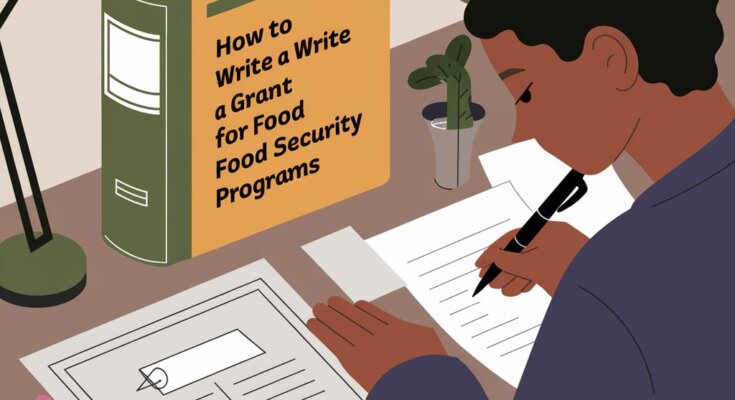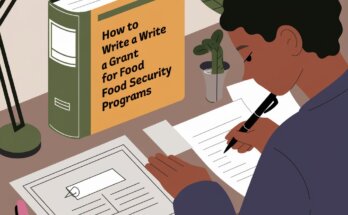Writing a grant proposal for food security programs can be a crucial step for nonprofits looking to tackle hunger and malnutrition in their communities.
A well-crafted proposal not only helps secure funding, but also allows organizations to clearly articulate their mission and impact.
In this comprehensive guide, we will walk you through the essential components of a successful grant proposal, offering practical examples and insights to make the process easier and more effective.
Understanding the Importance of Food Security
Before diving into the proposal writing process, it’s essential to understand what food security means.
Food security exists when all people have physical, social, and economic access to sufficient, safe, and nutritious food to meet their dietary needs for an active and healthy life.
Unfortunately, millions of people face food insecurity due to factors such as poverty, unemployment, and systemic inequality.
By focusing on food security programs, nonprofits can play a significant role in alleviating hunger and improving the well-being of individuals and communities.
This understanding should guide your proposal writing process.
Step 1: Research Your Funding Sources
The first step in writing a grant proposal is to identify potential funding sources.
Research foundations, government agencies, and organizations that prioritize funding for food security initiatives.
Each funding body has its own set of priorities and criteria, so take the time to understand their goals.
Example of Researching Funding Sources
Suppose your organization wants to create a food pantry for low-income families. Research local foundations that support community health and wellness initiatives.
For instance, the Feeding America network often collaborates with local organizations to combat hunger and may have grants available for food security projects.
Step 2: Understand the Grantor’s Perspective
When writing a grant proposal, it’s crucial to view your project from the grantor’s perspective. They want to ensure their funds are used effectively and that your program aligns with their mission.
Align Your Mission with Their Goals
Make sure to clearly articulate how your project aligns with the grantor’s objectives. Use their language and focus on outcomes they value, such as community impact and sustainability.
Example: If a foundation prioritizes community health, emphasize how your food security program will not only provide access to nutritious food, but also improve overall health outcomes for participants.
Step 3: Write a Compelling Executive Summary
The executive summary is the first section of your proposal and serves as an introduction to your project. It should be concise, engaging, and informative.
Key Components of an Executive Summary
- Program Overview: Briefly describe your food security program, its goals, and the target population.
- Funding Request: Clearly state the amount of funding you are requesting.
- Impact: Summarize the expected outcomes and benefits of your program.
Example of an Executive Summary:
“Our nonprofit, Healthy Communities, is seeking $75,000 to launch a community food pantry that will serve low-income families in our area.
This initiative aims to provide nutritious food options, reduce food insecurity by 40%, and promote healthy eating habits. With your support, we can make a significant impact on the lives of those in need.”
Step 4: Define the Problem
In this section, you need to articulate the specific food security issue your program addresses. This is your opportunity to provide compelling data and personal stories that highlight the urgency of the problem.
Use Statistics and Personal Stories
Statistics can effectively convey the severity of food insecurity. Use credible sources to back up your claims. For instance, according to the USDA, 10.5% of U.S. households were food insecure at some point in 2020.
Personal Story Example
Story of Mary:
Meet Mary, a single mother of three living in an underserved community. With rising costs of living and a limited income, Mary often struggles to provide her children with healthy meals. Last month, she had to skip grocery shopping for an entire week, relying on friends for food.
Sharing stories like Mary’s helps grantors understand the real impact of food insecurity on individuals.
Step 5: Outline Your Objectives
Your program objectives should be clear, measurable, and aligned with the overall mission of addressing food insecurity. Use the SMART criteria to ensure your objectives are Specific, Measurable, Achievable, Relevant, and Time-bound.
Example of SMART Objectives
- Specific: Provide fresh fruits and vegetables to 150 families each month.
- Measurable: Track the number of families served and the quantity of food distributed.
- Achievable: Based on past outreach efforts, we know we can attract community members to participate.
- Relevant: This aligns with our mission to improve community health.
- Time-bound: Achieve this within the first 12 months of operation.
Step 6: Describe Your Program
Detail the activities and strategies your program will implement to achieve the outlined objectives. This section should provide a clear roadmap of how you plan to execute your project.
Key Components to Include
- Activities: What specific actions will you take? (e.g., food distribution, nutrition workshops)
- Timeline: Provide a timeline for the implementation of each activity.
- Staffing: Identify who will be involved in the program and their roles.
Example of Program Description:
“Our program will operate on a monthly basis, providing fresh produce and pantry staples to families in need. Each month, we will host a community food distribution event and offer cooking demonstrations to teach healthy meal preparation. We anticipate serving 150 families at each event, distributing over 2,000 pounds of food monthly.”
Step 7: Develop a Budget
A well-prepared budget is essential for any grant proposal. It should clearly outline how the funds will be allocated and demonstrate that you have considered all potential costs.
Create a Detailed Budget
Your budget should include line items for personnel, materials, equipment, and any overhead costs. Be transparent about how each expense supports your program objectives.
Example of Budget Breakdown:
| Expense | Cost |
|---|---|
| Personnel (Coordinator) | $30,000 |
| Food Supplies | $25,000 |
| Marketing and Outreach | $10,000 |
| Workshops and Training | $5,000 |
| Total | $70,000 |
Step 8: Evaluation Plan
Funders want to know how you will measure the success of your program. Define clear metrics and methods for evaluation.
Use Quantifiable Metrics
Your evaluation plan should outline how you will collect data and analyze outcomes.
Example of Evaluation Plan:
“We will conduct monthly surveys to assess the number of families served and the variety of food distributed. Additionally, we will track changes in food security status through follow-up interviews every three months.”
Step 9: Write a Strong Conclusion
Wrap up your proposal by reiterating the importance of your program and the potential impact of the funding.
Make a Direct Appeal
End with a compelling call to action, asking the grantor to support your initiative and invest in the community’s future.
Example of Conclusion:
“With your support, we can transform lives by providing access to nutritious food and empowering families to lead healthier lives. Together, we can combat food insecurity in our community.”
Proofread and Review
Before submitting your grant proposal, make sure to proofread and review it multiple times. Grammatical errors or unclear language can detract from the professionalism of your proposal.
Seek Feedback from Peers
Consider asking colleagues or other nonprofit professionals to review your proposal. Fresh eyes can catch mistakes and provide valuable feedback.
Take Action
Writing a grant proposal for food security programs is a vital step in addressing hunger in your community. By following these steps and crafting a compelling narrative, you can significantly increase your chances of securing funding.
Remember that the journey may be challenging, but persistence and clarity in your proposal will pay off. Don’t hesitate to reach out for help and continually seek ways to improve your grant-writing skills.
If you’re looking for more expert tips, resources, and exclusive opportunities, be sure to subscribe to the Nonprofit Navigators Newsletter.
By joining, you’ll gain access to job openings, grant opportunities, webinars, events, and much more that will help elevate your nonprofit organization.
I’m Queen Israel Nweke! I help nonprofits thrive by mastering grant writing, strategic funding, and effective nonprofit management, enabling them to secure resources and make a lasting impact in their communities. Interested in any of these services? Contact me at nonprofitnavigatorsconsult@gmail.com.
>>>>Recommended Resources>>>>>
- The Small Business’s Guide to Winning Grants
- Request for Proposal Success: How to Write Proposals That Win
- The Ultimate Guide to Federal Grant Applications: Techniques for Success
- Digital Marketing for Nonprofits: A Comprehensive Guide to Boosting Your Impact Online
- Mastering Online Fundraising: A Nonprofit’s Guide to Digital Success




